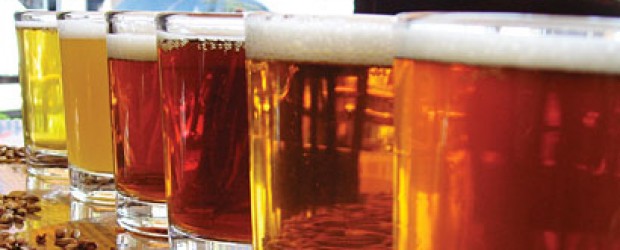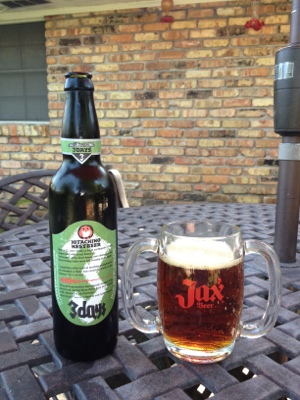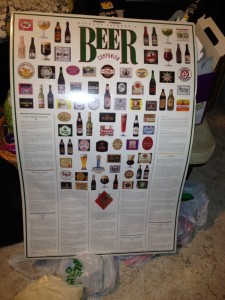So our Brasseurs a la Maison club competition is porter for the sake of sending the beer to the club competition in the AHA. This was coincidental to my latest decision to go on a British style brewing rampage so I’m pushing the ESB and sweet stout until July although I’m ordering all the ingredients for all of the brews. I love the English style brown porters especially the Taddy porter from Samuel Smith. I’ll be brewing Jamil’s with a slight variation in chocolate and crystal malts. I want more actual chocolate taste so I’ll be using pale chocolate. Pale chocolate is slightly sweet so I’ll reduce the crystal addition. Hopefully it’ll work out and be a a very nice porter. Salt additions will likely involve calcium carbonate, gypsum and/or Epson salts.
Here is the original brew game plan:
Mash Water Modification For 5 gallons prepared mash water volume with the intention of using 4 of it. 75% Baton Rouge water 25% distilled with 3/4 teaspoon chalk, 1/4 teaspoon Epson salt and 1/3 teaspoon calcium chloride. If we drop the volume to 4 gallons prepared the chalk will become 1/2 teaspoon and the calcium chloride 1/4 teaspoon. 1 teaspoon of Irish Moss rehydrated.
How it went down:
Everything went very smooth. I hit the mash temperature right but for some reason before I could run off enough liquid the gravity fell below 1.010 which caused me to stop it there. Original gravity was about 1.049 which is slightly lower but I think it’s because the grain ran clean fast. I may need to adjust my efficiency or just run off more wort until I get to the 1.007 area.
After 10 days the final gravity was at 1.013 which tends to make me think adding a little DME would’ve been a good idea in this situation. However the results I got resulted in a great tasting beer with a nice balance of chocolate, roast, nutty and sweet flavors. Currently carbonating.
Name: Baton Rouge Brown Porter
Description: A classic porter. Mash at 153F for 60 minutes.. ferment at 67F. the chocolate is pale chocolate and the carafa is because i dont have time to age the acrid roast maltS. 1 teaspoon irish moss and modify water for carbonate profile using 3/4 tsp chalk, 1/4 tsp epson and 1/4 tsp calcium chloride. 4 gallons mash water with 5 prepared. btr water
Post Boil Volume: 6.00
Pre Boil Volume: 7.00
Mash Time: 60.00
Boil Time: 75.00
Desired Original Gravity: 1.052
Desired Final Gravity: 1.013
Calculated Likely ABV% Based on Specified Gravities: 5.120
Users Targeted ABV%: 5.000
Desired CO2 Volumes: 2
Anticipated Brewhouse Efficiency: 70
Likely Original Gravity at 6.00 Based on Grains and Efficiency: @ 70% = 334 GU = 1.056
Grain: Caramel/Crystal Malt – 40L qty:0.5
Grain: Pale Malt, Maris Otter qty:10
Grain: Brown Malt qty:1
Grain: Chocolate Malt qty:0.5
Grain: Caramel/Crystal Malt – 20L qty:0.5
Grain: Carafa II qty:0.5
Hop : Fuggles qty:2 at:60 mins. AA=4.50
Hop : Fuggles qty:1 at:10 mins. AA=4.50
Yeast: Burton Ale qty:2 Max temp: 73.0 Min temp: 68.0
Style Name: Brown Porter (Porter)
Baton Rouge Brown Porter Pocket Brewer XML Code»
Baton Rouge Brown Porter BeerXML Code»
Sent from my Windows Phone
<?xml version=”1.0″ encoding=”utf-16″?>
<RecipeClass>
<BREWER>Pocket Brewer</BREWER>
<Type>All Grain</Type>
<VERSION>1</VERSION>
<OriginalGravity>1.052</OriginalGravity>
<OriginalGravityImportExport>1.052</OriginalGravityImportExport>
<FinalGravityImportExport>1.013</FinalGravityImportExport>
<FinalGravity>1.013</FinalGravity>
<BatchSize>6</BatchSize>
<BatchSizeImportExport>6</BatchSizeImportExport>
<BoilVolumeSize>7</BoilVolumeSize>
<BoilVolumeSizeImportExport>7</BoilVolumeSizeImportExport>
<CO2Volumes>2</CO2Volumes>
<BoilTime>75</BoilTime>
<MashTime>60</MashTime>
<TargetABV>5</TargetABV>
<BrewHouseEfficiency>70</BrewHouseEfficiency>
<Name>Baton Rouge Brown Porter</Name>
<Style />
<Description>A classic porter. Mash at 153F for 60 minutes.. ferment at 67F. the chocolate is pale chocolate and the carafa is because i dont have time to age the acrid roast maltS. 1 teaspoon irish moss and modify water for carbonate profile using 3/4 tsp chalk, 1/4 tsp epson and 1/4 tsp calcium chloride. 4 gallons mash water with 5 prepared. btr water</Description>
<StyleIdExact>12A</StyleIdExact>
<StyleIdGeneral>12</StyleIdGeneral>
<Yeasts>
<YeastAdditionClass>
<Quantity>2</Quantity>
<Name>Burton Ale</Name>
<ProductID>WLP023</ProductID>
</YeastAdditionClass>
</Yeasts>
<Hops>
<HopAdditionClass>
<USE>Boil</USE>
<VERSION>1</VERSION>
<NOTES>Used For: General purpose bittering/aroma for English Ales, Dark Lagers</NOTES>
<QuantityIO>2</QuantityIO>
<Quantity>2</Quantity>
<QuantityText>2</QuantityText>
<Alpha>4.50</Alpha>
<AlphaText>4.50</AlphaText>
<TinsethIBUS>26</TinsethIBUS>
<IsWholeHop>false</IsWholeHop>
<TimeInMinutes>60</TimeInMinutes>
<TimeInMinutesText>60</TimeInMinutesText>
<Name>Fuggles</Name>
<Visible>Visible</Visible>
</HopAdditionClass>
<HopAdditionClass>
<USE>Boil</USE>
<VERSION>1</VERSION>
<NOTES>Used For: General purpose bittering/aroma for English Ales, Dark Lagers</NOTES>
<QuantityIO>1</QuantityIO>
<Quantity>1</Quantity>
<QuantityText>1</QuantityText>
<Alpha>4.50</Alpha>
<AlphaText>4.50</AlphaText>
<TinsethIBUS>5</TinsethIBUS>
<IsWholeHop>false</IsWholeHop>
<TimeInMinutes>10</TimeInMinutes>
<TimeInMinutesText>10</TimeInMinutesText>
<Name>Fuggles</Name>
<Visible>Visible</Visible>
</HopAdditionClass>
</Hops>
<Grains>
<GrainAdditionClass>
<QuantityIO>0.5</QuantityIO>
<VERSION>1</VERSION>
<YIELD>74.00</YIELD>
<COLOR>40.0</COLOR>
<ORIGIN>US</ORIGIN>
<SUPPLIER />
<NOTES />
<Quantity>0.5</Quantity>
<PotentialSpecificGravity>1.034</PotentialSpecificGravity>
<Type>Grain</Type>
<Name>Caramel/Crystal Malt – 40L</Name>
</GrainAdditionClass>
<GrainAdditionClass>
<QuantityIO>10</QuantityIO>
<VERSION>1</VERSION>
<YIELD>82.50</YIELD>
<COLOR>3.0</COLOR>
<ORIGIN>United Kingdom</ORIGIN>
<SUPPLIER>Maris Otter</SUPPLIER>
<NOTES>Premium base malt from the UK. Popular for many English styles of beer including ales, pale ales and bitters.</NOTES>
<Quantity>10</Quantity>
<PotentialSpecificGravity>1.038</PotentialSpecificGravity>
<Type>Grain</Type>
<Name>Pale Malt, Maris Otter</Name>
</GrainAdditionClass>
<GrainAdditionClass>
<QuantityIO>1</QuantityIO>
<VERSION>1</VERSION>
<YIELD>70.00</YIELD>
<COLOR>65.0</COLOR>
<ORIGIN>United Kingdom</ORIGIN>
<SUPPLIER />
<NOTES>Imparts a dry, biscuit flavor. Used in nut brown ales, porters and some Belgian ales.</NOTES>
<Quantity>1</Quantity>
<PotentialSpecificGravity>1.032</PotentialSpecificGravity>
<Type>Grain</Type>
<Name>Brown Malt</Name>
</GrainAdditionClass>
<GrainAdditionClass>
<QuantityIO>0.5</QuantityIO>
<VERSION>1</VERSION>
<YIELD>60.00</YIELD>
<COLOR>350.0</COLOR>
<ORIGIN>US</ORIGIN>
<SUPPLIER />
<NOTES />
<Quantity>0.5</Quantity>
<PotentialSpecificGravity>1.028</PotentialSpecificGravity>
<Type>Grain</Type>
<Name>Chocolate Malt</Name>
</GrainAdditionClass>
<GrainAdditionClass>
<QuantityIO>0.5</QuantityIO>
<VERSION>1</VERSION>
<YIELD>75.00</YIELD>
<COLOR>20.0</COLOR>
<ORIGIN>US</ORIGIN>
<SUPPLIER />
<NOTES />
<Quantity>0.5</Quantity>
<PotentialSpecificGravity>1.035</PotentialSpecificGravity>
<Type>Grain</Type>
<Name>Caramel/Crystal Malt – 20L</Name>
</GrainAdditionClass>
<GrainAdditionClass>
<QuantityIO>0.5</QuantityIO>
<VERSION>1</VERSION>
<YIELD>70.00</YIELD>
<COLOR>412.0</COLOR>
<ORIGIN>Germany</ORIGIN>
<SUPPLIER>Weyermann</SUPPLIER>
<NOTES>Used to intensify aroma and color in dark, Munich beers and stouts.</NOTES>
<Quantity>0.5</Quantity>
<PotentialSpecificGravity>1.032</PotentialSpecificGravity>
<Type>Grain</Type>
<Name>Carafa II</Name>
</GrainAdditionClass>
</Grains>
<Adjuncts />
<MISCS />
<WATERS />
<MASH>
<MASH_STEPS />
<VERSION>0</VERSION>
<GRAIN_TEMP>0</GRAIN_TEMP>
<TUN_TEMP>0</TUN_TEMP>
<SPARGE_TEMP>0</SPARGE_TEMP>
<PH>0</PH>
<TUN_WEIGHT>0</TUN_WEIGHT>
<TUN_SPECIFIC_HEAT>0</TUN_SPECIFIC_HEAT>
</MASH>
<Id>f34cf186-c38b-4944-be2d-df1cb5e73388</Id>
<BrewHouse>
<Efficiency>70</Efficiency>
</BrewHouse>
</RecipeClass>
<?xml version=”1.0″ encoding=”utf-16″?>
<RECIPE>
<NAME>Baton Rouge Brown Porter</NAME>
<VERSION>1</VERSION>
<TYPE>All Grain</TYPE>
<NOTES>A classic porter. Mash at 153F for 60 minutes.. ferment at 67F. the chocolate is pale chocolate and the carafa is because i dont have time to age the acrid roast maltS. 1 teaspoon irish moss and modify water for carbonate profile using 3/4 tsp chalk, 1/4 tsp epson and 1/4 tsp calcium chloride. 4 gallons mash water with 5 prepared. btr water</NOTES>
<BREWER>Pocket Brewer</BREWER>
<BATCH_SIZE>22.7115</BATCH_SIZE>
<BOIL_TIME>75</BOIL_TIME>
<BOIL_SIZE>26.4968</BOIL_SIZE>
<EFFICIENCY>70</EFFICIENCY>
<FG>1.013</FG>
<OG>1.052</OG>
<CARBONATION>2</CARBONATION>
<HOPS>
<HOP>
<NAME>Fuggles</NAME>
<VERSION>1</VERSION>
<ALPHA>4.50</ALPHA>
<AMOUNT>0.0567</AMOUNT>
<USE>Boil</USE>
<TIME>60</TIME>
<NOTES>Used For: General purpose bittering/aroma for English Ales, Dark Lagers</NOTES>
</HOP>
<HOP>
<NAME>Fuggles</NAME>
<VERSION>1</VERSION>
<ALPHA>4.50</ALPHA>
<AMOUNT>0.0283</AMOUNT>
<USE>Boil</USE>
<TIME>10</TIME>
<NOTES>Used For: General purpose bittering/aroma for English Ales, Dark Lagers</NOTES>
</HOP>
</HOPS>
<FERMENTABLES>
<FERMENTABLE>
<NAME>Caramel/Crystal Malt – 40L</NAME>
<VERSION>1</VERSION>
<AMOUNT>0.2268</AMOUNT>
<TYPE>Grain</TYPE>
<YIELD>74.00</YIELD>
<COLOR>40.0</COLOR>
<ORIGIN>US</ORIGIN>
<SUPPLIER />
<NOTES />
<COARSE_FINE_DIFF>1.50</COARSE_FINE_DIFF>
<MOISTURE>4.00</MOISTURE>
<DISASTATIC_POWER>0.0</DISASTATIC_POWER>
<PROTEIN>13.20</PROTEIN>
<MAX_IN_BATCH>20.00</MAX_IN_BATCH>
<POTENTIAL>1.034</POTENTIAL>
</FERMENTABLE>
<FERMENTABLE>
<NAME>Pale Malt, Maris Otter</NAME>
<VERSION>1</VERSION>
<AMOUNT>4.5359</AMOUNT>
<TYPE>Grain</TYPE>
<YIELD>82.50</YIELD>
<COLOR>3.0</COLOR>
<ORIGIN>United Kingdom</ORIGIN>
<SUPPLIER>Maris Otter</SUPPLIER>
<NOTES>Premium base malt from the UK. Popular for many English styles of beer including ales, pale ales and bitters.</NOTES>
<COARSE_FINE_DIFF>1.50</COARSE_FINE_DIFF>
<MOISTURE>3.00</MOISTURE>
<DISASTATIC_POWER>120.0</DISASTATIC_POWER>
<PROTEIN>11.70</PROTEIN>
<MAX_IN_BATCH>100.00</MAX_IN_BATCH>
<POTENTIAL>1.038</POTENTIAL>
</FERMENTABLE>
<FERMENTABLE>
<NAME>Brown Malt</NAME>
<VERSION>1</VERSION>
<AMOUNT>0.4536</AMOUNT>
<TYPE>Grain</TYPE>
<YIELD>70.00</YIELD>
<COLOR>65.0</COLOR>
<ORIGIN>United Kingdom</ORIGIN>
<SUPPLIER />
<NOTES>Imparts a dry, biscuit flavor. Used in nut brown ales, porters and some Belgian ales.</NOTES>
<COARSE_FINE_DIFF>1.50</COARSE_FINE_DIFF>
<MOISTURE>4.00</MOISTURE>
<DISASTATIC_POWER>0.0</DISASTATIC_POWER>
<PROTEIN>0.00</PROTEIN>
<MAX_IN_BATCH>10.00</MAX_IN_BATCH>
<POTENTIAL>1.032</POTENTIAL>
</FERMENTABLE>
<FERMENTABLE>
<NAME>Chocolate Malt</NAME>
<VERSION>1</VERSION>
<AMOUNT>0.2268</AMOUNT>
<TYPE>Grain</TYPE>
<YIELD>60.00</YIELD>
<COLOR>350.0</COLOR>
<ORIGIN>US</ORIGIN>
<SUPPLIER />
<NOTES />
<COARSE_FINE_DIFF>1.50</COARSE_FINE_DIFF>
<MOISTURE>4.00</MOISTURE>
<DISASTATIC_POWER>0.0</DISASTATIC_POWER>
<PROTEIN>13.20</PROTEIN>
<MAX_IN_BATCH>10.00</MAX_IN_BATCH>
<POTENTIAL>1.028</POTENTIAL>
</FERMENTABLE>
<FERMENTABLE>
<NAME>Caramel/Crystal Malt – 20L</NAME>
<VERSION>1</VERSION>
<AMOUNT>0.2268</AMOUNT>
<TYPE>Grain</TYPE>
<YIELD>75.00</YIELD>
<COLOR>20.0</COLOR>
<ORIGIN>US</ORIGIN>
<SUPPLIER />
<NOTES />
<COARSE_FINE_DIFF>1.50</COARSE_FINE_DIFF>
<MOISTURE>4.00</MOISTURE>
<DISASTATIC_POWER>0.0</DISASTATIC_POWER>
<PROTEIN>13.20</PROTEIN>
<MAX_IN_BATCH>20.00</MAX_IN_BATCH>
<POTENTIAL>1.035</POTENTIAL>
</FERMENTABLE>
<FERMENTABLE>
<NAME>Carafa II</NAME>
<VERSION>1</VERSION>
<AMOUNT>0.2268</AMOUNT>
<TYPE>Grain</TYPE>
<YIELD>70.00</YIELD>
<COLOR>412.0</COLOR>
<ORIGIN>Germany</ORIGIN>
<SUPPLIER>Weyermann</SUPPLIER>
<NOTES>Used to intensify aroma and color in dark, Munich beers and stouts.</NOTES>
<COARSE_FINE_DIFF>1.50</COARSE_FINE_DIFF>
<MOISTURE>4.00</MOISTURE>
<DISASTATIC_POWER>0.0</DISASTATIC_POWER>
<PROTEIN>11.70</PROTEIN>
<MAX_IN_BATCH>5.00</MAX_IN_BATCH>
<POTENTIAL>1.032</POTENTIAL>
</FERMENTABLE>
</FERMENTABLES>
<MISCS />
<WATERS />
<YEASTS>
<YEAST>
<NAME>Burton Ale</NAME>
<TYPE>Ale</TYPE>
<VERSION>0</VERSION>
<FORM>Liquid</FORM>
<AMOUNT>2</AMOUNT>
<LABORATORY>White Labs</LABORATORY>
<PRODUCT_ID>WLP023</PRODUCT_ID>
<MIN_TEMPERATURE>68.0</MIN_TEMPERATURE>
<MAX_TEMPERATURE>73.0</MAX_TEMPERATURE>
<ATTENUATION>72.00</ATTENUATION>
<NOTES>Burton-on-trent yeast produces a complex character. Flavors include apple, pear, and clover honey.</NOTES>
<BEST_FOR>All English styles including Pale Ale, IPA, Porter, Stout and Bitters.</BEST_FOR>
<FLOCCULATION>Medium</FLOCCULATION>
</YEAST>
</YEASTS>
<MASH>
<MASH_STEPS />
<VERSION>0</VERSION>
<GRAIN_TEMP>0</GRAIN_TEMP>
<TUN_TEMP>0</TUN_TEMP>
<SPARGE_TEMP>0</SPARGE_TEMP>
<PH>0</PH>
<TUN_WEIGHT>0</TUN_WEIGHT>
<TUN_SPECIFIC_HEAT>0</TUN_SPECIFIC_HEAT>
</MASH>
<STYLE>
<NAME>Brown Porter</NAME>
<CATEGORY>Porter</CATEGORY>
<CATEGORY_NUMBER>12</CATEGORY_NUMBER>
<STYLE_LETTER>A</STYLE_LETTER>
<STYLE_GUIDE>BJCP</STYLE_GUIDE>
<VERSION>1</VERSION>
<TYPE>Ale</TYPE>
<OG_MIN>1.040</OG_MIN>
<OG_MAX>1.052</OG_MAX>
<FG_MIN>1.008</FG_MIN>
<FG_MAX>1.014</FG_MAX>
<IBU_MIN>18</IBU_MIN>
<IBU_MAX>35</IBU_MAX>
<COLOR_MIN>20.0</COLOR_MIN>
<COLOR_MAX>30.0</COLOR_MAX>
<ABV_MIN>4.0</ABV_MIN>
<ABV_MAX>5.4</ABV_MAX>
<NOTES>Differs from a robust porter in that it usually has softer, sweeter and more caramelly flavors, lower gravities, and usually less alcohol. More substance and roast than a brown ale. Higher in gravity than a dark mild. Some versions are fermented with lager yeast. Balance tends toward malt more than hops. Usually has an “English” character. Historical versions with Brettanomyces, sourness, or smokiness should be entered in the Specialty Beer category (23).</NOTES>
</STYLE>
</RECIPE>


